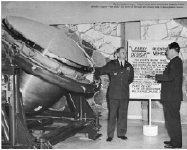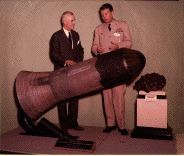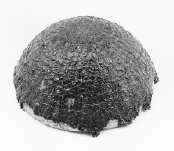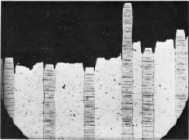 |
48 (2) (1996), pp. 45-48. JOM is a publication of The Minerals, Metals & Materials Society |
|---|
 |
48 (2) (1996), pp. 45-48. JOM is a publication of The Minerals, Metals & Materials Society |
|---|
Metallurgy and materials were and remain vital support functions for the teams that build, sell, and operate systems. The design buzz words were, and are, parameter studies and specific properties—the properties normalized by density. By 1950, metallurgy in graduate schools had become the physics of metals, and the writings of Hume-Rothery of England and Frederick Seitz of the United States explained how the solid-state theory predicted the potential of 100 times the tensile strengths for the defect-free or perfect crystals.
Large corporations invested in vast laboratories (e.g., U.S. Steel, AT&T, IBM, and General Electric), forming research centers built around physicists, not metallurgists. While solid-state physics launched electronics into its new era and phenomenal growth, the U.S. steels have folded into history—but so, by the way, have many of the idyllic basic research centers, their scientists now becoming professors. On the electronics side, the industrial investments were well rewarded, but the mechanical and structural payoffs lagged for decades. Metallurgical engineering became materials science, and we chased dislocations in search of perfect crystal structures. But the love affair with science was at the cost of engineering education, and the United States lost its backbone of heavy industry. Chemical engineering remained strong, and their graphite fibers and high-molecular-weight, organic-spun filaments eventually became commercial (e.g., Kevlar and Spectra).
Nature had evolved the fibers and structures like flax and bamboo, and we learned to design and build with fiberglass and the advanced composites to use our new exotic high-modulus yarns. After great government investments for military aircraft and space vehicles, the graphite-reinforced plastics revolutionized sporting goods and the many composite applications built on the fiberglass-plastics technology.
While steel wire and fiberglass are reliable and economic, the filaments of aramid, high-density polyethylene, and liquid-crystal organic fibers have transplaced the steel and augmented the glass fiber for many applications in spite of high costs. The high-alloy steels, high-modulus metals, and ceramic filaments have found phenomenal applications, as have the fiber optics and superconductor compounds. But the ultimate solid-state theory goals for the strength of materials and structures have yet to be met commercially.
With the Cold War as a driving force, the U.S. Air Force established parallel efforts on major components, such as the efforts of General Electric versus Avco on the re-entry vehicles (RVs) that would carry atomic warheads. The rocket engine would accelerate the RV to 25,000 miles per hour to escape the Earth's gravitational force and enter through the stratosphere, converting the kinetic energy into thermal energy. Calculating the compression effects was a new science, and only a small fraction of that energy could vaporize the re-entering vehicle. If the vehicle did not tumble and entered with laminar flow and no turbulence, the heat transfer could be calculated. Figure 1 shows the final hardware—a five-foot diameter, blunt-nose cone that would be stable.1 A 1,000 pound, copper-clad 316 stainless steel shell was manufactured by electroforming, possessing an outer skin of nickel and a reflective platinum final surface. Any imperfections could cause turbulence, hot spots, and destruction. The design was the precursor for the manned Mercury flights with beryllium heat sinks and the subsequent Gemini and Apollo flights, which had head shields instead of heat sinks, but the same blunt shapes.

Figure 1. The copper heat sink of the intercontinental ballistic missile (ICBM).
Today, cladding is very common, as seen in coins, cooking ware, armor, and other items. But the 1,000 pound, five-foot RV was challenging at the time. This metal composite was only a clad structure, but the R&D that combined aerospace research, physics, thermodynamics, and materials required good teams of engineers, scientists, and managers. As we progressed to larger rocket motors, the IRBM became intercontinental—the ICBM. Testing facilities to prove the concepts and the hardware were awesome in order to simulate great thermal energies, and testing included test flights over the oceans.
Heat-sink production was being set up when the war game changed, because the slow IRBM was deemed too vulnerable. A re-entry at much higher velocities was needed, but the metal composite heat sink would vaporize like a meteor. The aerodynamicist's answer from experiments with gas guns and theoretical calculations was the concept of ablation by vaporizing silica as the thermal barrier. This was the heat sink. They experimented with quartz, and the full-scale hardware challenge was to make a reliable silica nose cone—a one foot bowl—of quartz.

Figure 2. A RVX-1 thorable ICBM test vehicle and a meteorite at the Smithsonian Institute, Washington, D.C. (May 14, 1959).
Figure 22 shows Air Force Brigadier General Shreaver presenting the first and only recovered re-entry vehicle to the Smithsonian Institute in May 1959. Figure 32 is a close-up of the recovered nose cap—a fused silica hot pressed into an Inconel honeycomb. The cylinder and stabilizing tail was a composite of refrasil-phenolic. The viscous flow of the molten silica over the nose cap was uniform, carrying over to the cylinder section where the phenolic charred and had the low thermal conductivity needed to protect the payload. This particular RV had flown more than 5,000 miles over the Pacific, landed on target in a bay at Kwajeline, and been recovered. Many ground tests had demonstrated the RV's resistance to thermal shock and its reliable ablative behavior. Aft of the nose, the heat shield of refrasil-phenolic had been made of a successful reinforced plastic used in rocket motors as far back as the V-2s.

Figure 3. An ICBM Nose-cap (the same as the one in Figure 2), composed of a silica-Inconel composite, after re-entry.
Full-scale versions of both IRBMs and ICBMs were made, followed by a series of improvements that led to pyrolytic graphites (P/G) and three-dimensional woven graphite fiber as the modern graphite composites. For solid-propellant rockets, the early reinforced plastics led to P/G nozzles. Today, the space shuttle is protected by composite ceramic tiles, a larger scale version of the Avcoite. The ultrasonic aircraft develop high temperatures at leading edges and have to use superalloy honeycomb composites so that hot structures and heat shield materials continue to be optimized. But the most efficient system to this day is ablation using water.
But it was the improvement of graphite fiber that led to the major jump in mechanical advantages for military and sports applications. A sprinkling of boron now turned up but, just like the early gasoline with boron, its contribution was minor; still, it sold. The large modulus differences for fiber and matrix were also accompanied by large differences in expansion coefficients and consequent residual thermal stresses.

Figure 4. Isoclinic stress patterns around a whisker/resin composite.
This early world of whiskers was studied with birefringence, as shown in Figure 4. In 1963, David Schuster reported the magnitude and distribution of thermal stresses around alumina whiskers3 after having grown and harvested the crystals. His early color Polaroid birefringence stress photographs won a first prize at an American Society for Metals exhibit. Composites ranging from chopped-glass, fiber-reinforced plaster to reactive, hot-pressed magnesia were studied for rule-of-mixtures behavior. NASA studies of tungsten-wire-reinforced copper were in vogue. In the late 1960s, tungsten-reinforced brass was made by explosive forming, and subsequent tests showed more than 12 percent elongation for these tungsten wire composites.4 The necking instability normally results in wire fracture, but this was inhibited by the ductile matrix, resulting in extensive multiple necking and more than 12 percent total elongation—six times the stretch-to-failure for the tungsten wire (Figure 5).

Figure 5. A tungsten wire/brass composite after 12% elongation.
The Advanced Research Project Agency's Materials Science Center at Cornell University financed these early studies long before composite fibers and resins proliferated. The larger-scale production of metal and ceramic composites eventually included Dave Schuster's tonnage production of particulate-reinforced aluminum composites by Alcan (i.e., Duralcan).
Weapons for war and sporting goods could afford the boron filaments manufactured by Avco and the continuous graphite fibers first made by Union Carbide. By 1970, the Cortland Line Company became a major supplier of graphite rods for fly fishing as well as graphite-reinforced fly reels. The success of graphite-epoxy for golf clubs, tennis rackets, and fishing rods encouraged the next wave of development—high-modulus organic filaments. All of the chemical laboratories had processes and patents for high molecular weight/high modulus organic fibers, but it was DuPont that made the plunge. Their marketing analysis projected large sales from the potential weight savings in rubber tires as a replacement for steel wire. Tires have been the most successful synthetic composite in history, using glass, steel, polyester, rayon, and now aramid. But the high cost of the DuPont Kevlar® fiber and potential liability problems restricted the market expansion, although the $100 million investment risk for production eventually paid off and was copied. But a strange thing happened along the way.
The Radiophysics Laboratory at Cornell operated the giant one mile telescope at Aerocibo in Puerto Rico for studying space communication. The vertical transmission antenna required guys to minimize movement, and the glass rope being used was not stiff enough. Their search for a higher modulus fiber led to the making of the first Kevlar guys, a by-product of consulting at the Cortland Line Company, known for its fly fishing rods and its earlier Cortland rackets (Wilson wood laminates). These were 1/2 inch parallel Kevlar 29 (with Fiber B) with polyurethane jackets.
The same process had been used for 20,000 foot tethers for observation balloons using both polyester and Kevlar. The braiding technology used for commercial synthetic ropes and fishing lines could be used to compete with steel wire and cable. The Cortland Line Company's 2,000 braiders could not only braid Kevlar for tires, but also assist the U.S. Navy, which needed 20,000 foot lines for its new sonobouy systems for detecting deep-diving Soviet submarines. These lines were 300 pound break strength Kevlar braided over insulated number 28 conductors, replacing short steel sonobouy cables. Meanwhile, the U.S. Army was testing Kevlar for hoist cables and sling legs with their helicopters (Figure 6). Steel cables were excellent, but they were heavy and conducted large static charges. The lighter nylon sling legs stretched and bounced. Gradually, the rugged field requirements were met using Kevlar.

Figure 6. Kevlar hoist cable and slings on the Sikorsky S-70 helicopter 12/88.
A new world of undersea and outer space applications arose, as did some very unique termination problems. With proper system and hardware design, the cables and ropes are reliable for static and dynamic applications, particularly for the end terminations. As towers and buildings increase in height, the steel cables for elevators and guys will give way to higher strength/lower weight fiber ropes, which also decrease motor and hoist hardware sizes.
Undersea mooring and towing lines of up to one million pounds break strength have been made and deployed successfully, replacing the much heavier chain and dangerous steel cables on barges, oil rigs, and buoys. Most seismic tow cables now have Kevlar-strength members, particularly where very long lengths of thousands of feet are involved. Many are electromechanical with insulated conductors for instruments and for powering motors. Computer-assisted design is used to optimize the construction of these synthetic fiber ropes and cables, and many now have both copper conductors and fiber-optics elements. In most instances, these are not simply static cables in conduits, but subject to extremes of dynamics, towing, and reeling at sea. To accommodate high impact loads, special composite conductors are made (called H-I wire), which allow for conductor elongation and for recovery.
The requirement for nylon ropes with conductors was revived for MICLIK, an acronym for the system of clearing mine fields for landing craft. A three-conductor system was used for explosives strung along the 500-1,000 foot ropes launched by rocket from a landing craft toward shore. The detonation cleared a wide path for attack craft. The same technique was used in the desert mine fields of the Gulf War to open the way for troops and tanks, with the H-I wire helical conductors absorbing the launching loads. A unique application of the composite H-I wire was the NASA space tether, which now will be reused for 20 kilometer instrument deployments. In this case, the helixed copper conductor over a flexible Nomex® core allows for the large changes in length with thermal expansion/contraction within the several hundred degree temperature changes for the tethered system.
The original tethers were 100 kilometers long braided Kevlar, but the experiments were changed to measure the Earth's magnetic field. The tether is deployed from a shuttle-mounted reel. It has an inner Nomex core (the elastic base), and the copper is spirally wound for the full tether length. The extruded Teflon® insulation is defect-free for 25 kilometers, and tested to withstand 10,000 volts. When the conducting tether is deployed out of the shuttle while orbiting in space and the wire cuts through the Earth's magnetic field, a voltage is generated, allowed to accumulate, and then discharged to generate power or propulsion. The braided Kevlar strength member with a break strength of 400 pounds minimum is protected from ultraviolet light with a braided Nomex outer jacket. These all happen to be DuPont patented and trademarked materials. The tether diameter is less than 0.1 inch and is shown in Figure 7. It is interesting that these tethers were made more than five years ago but still have the reliable long-term shelf life.

Figure 7. An exploded view of a Kevlar satellite composite tether construction.
Direct questions about this or any other JOM page to jom@tms.org.
| Search | TMS Document Center | Subscriptions | Other Hypertext Articles | JOM | TMS OnLine |
|---|